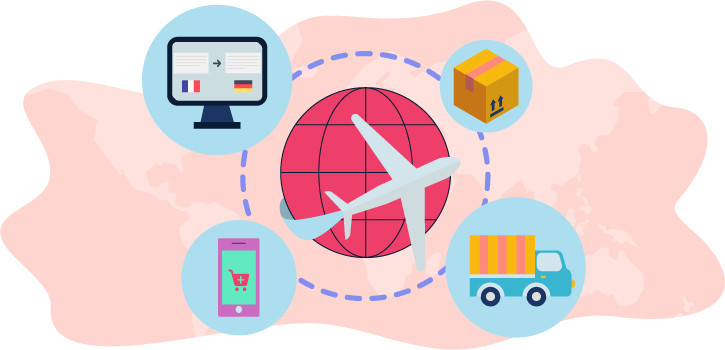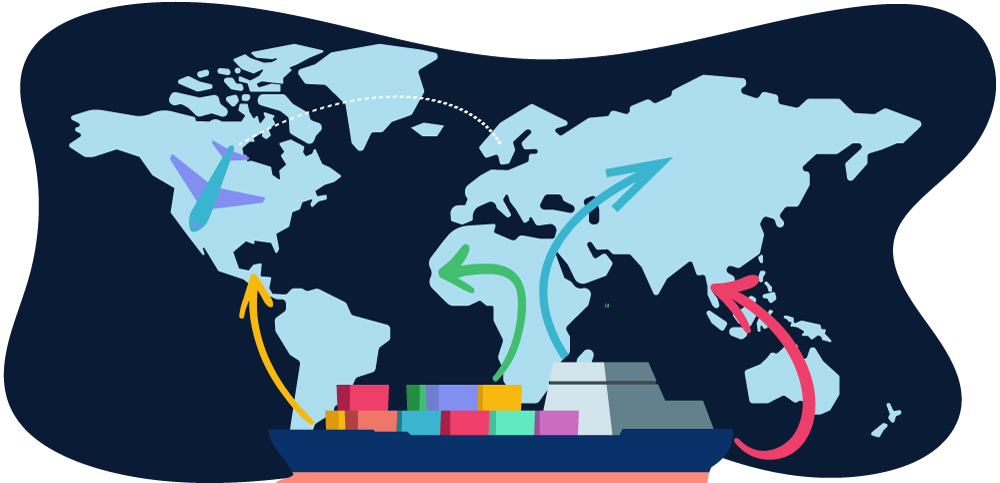Running a business is a venture that we tend to take one step at a time. Very few of us start out with high hopes of becoming the best in our field, a household name or an international name. Instead, we’re more drawn in by the opportunity to be our own boss, to get a fair share of the money we’re actually earning and to have control and flexibility within our career paths.
We want to design and sell products or services that we’re genuinely interested in or invested in. We want to learn the ins and outs of business operations. We want to spend our working life doing something that doesn’t bore us and leave us feeling at a dead end. While we still run into plenty of marketing challenges – it is all worth it.
So, when your business does start experiencing success and you do start actually seeing positive results, things can feel a little odd. You’ll have to start considering doing things that you might not have even anticipated yourself doing. Going global is one of these things! Selling goods to countries other than the one you’re operating with can further boost brand exposure and can maximise sales and profits.
This may seem daunting, but the good news is that taking your business international is now easier than ever when you run an ECommerce store. From e-signatures to other tools that help you go international – here are a few areas that you will need to focus on to make a success of this venture!
Focus On Market Due Diligence
The first step that you’ll have to take before plunging into attempting to establish your brand and sell internationally is to focus on market due diligence. Put simply, this is the process of gathering data from industry experts, competitors, customers, suppliers and other third-party market participants to determine whether your venture will likely be a success.
By bringing together and analysing data from all of these areas, you will generally gain a good idea of whether customers in the region you’re targeting will actually buy the products you’re planning on offering them. Often, two things will determine whether you will be encouraged or discouraged from proceeding. These are market volatility and local dynamics.
- Market volatility – your business’ success will likely depend on the stability or volatility of stocks in the area you’re planning on setting up. Stock market volatility can affect forecasts for future output across different countries.
- Local dynamics – what appeals to buyers you’ve been selling to in your country of operation may not appeal to buyers elsewhere. You need to understand buyer behaviour in different areas to determine whether you can sell to them or not.
You will also have to focus on SEO. Search engine optimisation can give great insight into the search behaviour and shopping behaviour of the target demographic you’re planning on expanding to. This, along with surveys, can help you to come up with a marketing plan if you do go ahead with this venture.
Another step that you need to take is to know who your competitors will be when you try to establish your brand in a different country. This will not only let you scope out competition, but it can also give you insight into local purchasing trends and you can see how these companies have been successful in driving consumer behaviour. This will give you a headstart, as you’ll be able to replicate this.
Focus On Your Website
Next, you need to focus on your website. It’s highly recommended that you use a shopping platform that can be used and will work internationally when you’re planning on expanding to an international market. Shopify is a good example. Not only is it simple to use from your end of things (as there’s a logical user interface), but it will also help you to create a functional and appealing website that will be simple and straightforward for your customers to use.
Platforms like this really allow you to focus on UX or “user experience”. Not only will their interaction with your website be seamless and have a fast page loading speed (preventing potential buyers from becoming frustrated and clicking the exit tab), but you’ll also be able to influence shopper behaviour by directing their attention to the parts of your site that you want them to focus on, like lead capture forms.
Once you’ve got your website up and running, it’s also important to ensure that it works well on mobile. Increasing numbers of people are shopping on mobile nowadays and you don’t want to miss out on these sales!
If you really want to get ahead of the competition, you could go all out and pay an app developer to create a branded mobile app for your company. You could also implement features such as AI and chatbots to answer customer queries and complaints.
Consider Shipping Options
Shipping, of course, is often a point of contention when it comes to operating internationally. It inevitably costs more to ship your products overseas than it will to ship domestically. Generally speaking, companies charge the full shipping cost to international customers in order to avoid impacting profits or making losses. But if people are paying a lot for shipping, you need to make sure that they get the best service. Find a high quality and reliable international courier to complete the task. Options like Easyship are useful. This is an international shipping platform that can handle plenty of deliveries.
A note to keep in mind is that you will need a thorough understanding of restricted goods when shipping internationally. Make sure you only ship authorised goods and ensure you have relevant licences and follow guidelines if you are shipping restricted items.
Understand Taxation
Taxation varies from one country to another. While you may have a good idea of the taxation rules of the company you’re operating within, you also need to understand taxation of goods and whether taxes apply to you when shipping internationally.
There may be customs, duties or other taxes that either you or your customers may have to deal with and be aware of. Make sure to figure out what GST and VAT are and what different taxes apply to the different goods you’re providing!
Marketing 200
Marketing can make or break whether your brand survives and thrives internationally – the same as how marketing can make or break your brand on home turf. But the marketing techniques and tactics that see sales skyrocket with the demographic you’re used to catering to might not always be the most effective marketing methods for international customers.
It’s generally a pretty good idea to have a local marketing team on board when you’re taking your company international or a Country Manager who will have multiple roles at the beginning, including local Marketing Manager. They’ll know the ins and outs of what works and what doesn’t with local customers. They’ll have experience with the demographic and will be able to offer insightful advice when it comes to your marketing approach. This will be more than worth the investment!
You may also want to find local influencers who can push your products and make your brand a more recognised name in the country or specific area you’re planning on catering to. Social media influencers, in particular, tend to have large local followings who trust them. Simply posting your brand or products on their feed regularly can make local consumers feel more familiar, comfortable with, interested in and likely to buy your products.
Don’t forget to focus on content marketing when you shift sales overseas. Having a blog is always a good thing and paid ads are a sound investment that will, again, regularly expose your newly established target demographic with your brand and the products that you’re offering.
In conclusion
Sure, this may seem like a whole lot of information to take on board. In some ways, taking your business international can almost feel like starting all over again. You’ll have a whole lot to learn in a relatively short time frame in order to hit the ground running and really make a success of this opportunity. But all in all, establishing your brand internationally is a venture well worth pursuing.
You never know where your biggest market could lie and catering to a wider audience simply means you’re much more likely to secure more and more sales. More sales mean more profit, a more secure business and a bigger presence. What’s not to love?
Hopefully, some of the information outlined above will be able to get you started out in the right direction. While it may be hard to go international – and you’re likely to experience some difficulties or hiccups along the way – it’s not impossible. With the right tools and the right team behind you, you’re already halfway there!
About the Article Editor:
Darya Jandossova Troncoso is a photographer, artist and writer working on her first novel and managing a digital marketing blog – MarketSplash. In her spare time, she enjoys spending time with her family, cooking, creating art and learning everything there is to know about digital marketing.







